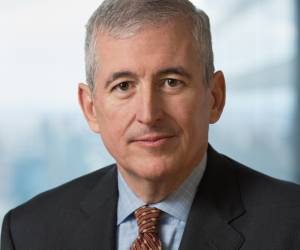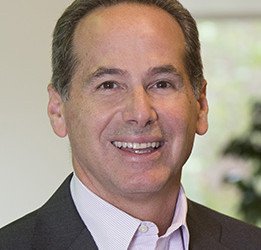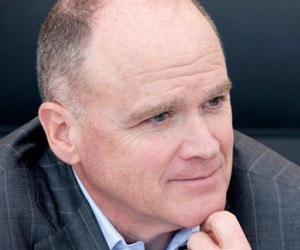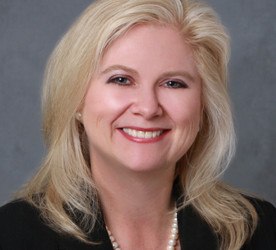

This article is part of our insurance innovators interview series.
 Stanley A. Galanski, President and CEO, The Navigators Group, Inc.
Stanley A. Galanski, President and CEO, The Navigators Group, Inc. Mark E. Watson III, President and Chief Executive Officer, Argo Group International Holdings, Ltd.
Mark E. Watson III, President and Chief Executive Officer, Argo Group International Holdings, Ltd. Kevin H. Kelley, Chief Executive Officer, Ironshore Inc.
Kevin H. Kelley, Chief Executive Officer, Ironshore Inc. John Wurzler, President, OneBeacon Technology Insurance
John Wurzler, President, OneBeacon Technology Insurance Alan B. Colberg, President and Chief Executive Officer, Assurant, Inc.
Alan B. Colberg, President and Chief Executive Officer, Assurant, Inc. Manny Rios, President and CEO, American Modern Insurance Group
Manny Rios, President and CEO, American Modern Insurance Group Dave Pratt, General Manager, Usage-Based Insurance, Progressive
Dave Pratt, General Manager, Usage-Based Insurance, Progressive Berto Sciolla, EVP and Manager of North American Treaty Reinsurance,Gen Re
Berto Sciolla, EVP and Manager of North American Treaty Reinsurance,Gen Re Greg Hendrick, Chief Executive, Insurance, XL Catlin
Greg Hendrick, Chief Executive, Insurance, XL Catlin Anand Rao, Principal, PwC U.S. Advisory Practice
Anand Rao, Principal, PwC U.S. Advisory Practice Mike McGavick, Chief Executive Officer, XL Catlin
Mike McGavick, Chief Executive Officer, XL Catlin David M. Lightfoot, Managing Director, Head of GC Analytics – Americas, Guy Carpenter
David M. Lightfoot, Managing Director, Head of GC Analytics – Americas, Guy Carpenter Conan Ward, Chief Executive Officer, Hamilton USA
Conan Ward, Chief Executive Officer, Hamilton USA Ming Lee, Chief Executive Officer, AIR Worldwide
Ming Lee, Chief Executive Officer, AIR Worldwide Laura Hay, National Insurance Sector Leader, KPMG LLP
Laura Hay, National Insurance Sector Leader, KPMG LLP John Lupica, Vice Chairman, ACE Group; Chairman, Insurance–North America
John Lupica, Vice Chairman, ACE Group; Chairman, Insurance–North America Anand Rao, Principal, PwC U.S. Advisory Practice
Anand Rao, Principal, PwC U.S. Advisory PracticeQ1: In your view, what has been the greatest innovation in the P/C insurance industry in recent years? Explain.
Rao (PwC): The greatest innovation in the P/C insurance industry is in the use of data and analytics to better understand risk and price it appropriately. Building predictive models using statistical techniques and machine learning techniques is revolutionizing how insurers are able to segment customers and their risk characteristics, evaluate terms and conditions, and maximize profitability.
Better understanding of risk also allows for greater standardization and as a result greater automation, further decreasing the costs of underwriting. Personal auto insurance is already heavily auto-underwritten. The trend continues with predictive models being built for home insurance, commercial property, workers compensation and other lines.
Cyber risk and supply chain risk are also gaining increasing attention with efforts to build predictive models that can help better assess and price these risks.
Q3: In your view, what innovation or innovator outside the insurance industry has had or is having the greatest impact on the P/C insurance industry?
Rao (PwC): The two greatest innovations outside of the insurance industry that are having and will have a significant impact on the P/C insurance industry are (a) big data and analytics and (b) the Internet of Things.
Big data and analytics are revolutionizing how insurers are conducting their marketing, sales, distribution, underwriting, operations, claims, finance and risk management functions. Analytics are transforming how executives are making decisions—driven more by facts and data than gut feel. They are facilitating more effective and efficient decisions and actions at both the strategic and operational levels.
The Internet of Things is essentially digitizing the physical world. By enabling sensors to be embedded in key assets, the ways in which insurance companies can monitor and protect the assets they insure are being transformed.
Anand Rao, PwC
Both these innovations will fundamentally transform insurance over the next decade to be more proactive and focused on risk management and loss management as opposed to being underwriting and claims management focused.
Q5: What is the biggest obstacle to innovation within the insurance industry? Explain. What is your company doing (or what can the industry do) to overcome this obstacle?
Rao (PwC): The biggest obstacle to innovation within the insurance industry is complacency and the mindset that insurance is a highly regulated industry with very little scope for innovation. PwC’s CEO Survey has consistently shown over the past few years that the insurance industry is one of a handful of industries—in the same group as entertainment, media and technology—that is facing significant business model disruption. Using regulation as an excuse for inaction will leave the door open for external players to disrupt the insurance industry.
[ijtv id=”12260″]
Q6: Do you believe the next innovation to impact the P/C insurance industry will come from inside the industry or from an external innovator? Why?
Rao (PwC): The next innovation in the insurance industry is very likely to come from a technology or a data-and-analytics player. The technological pace of change is accelerating and opening up new opportunities for technology companies to disrupt a variety of industries including insurance. The technology companies have the data, the talent and the funding to disrupt the insurance sector. Also, not having an existing infrastructure and revenues to protect makes it easier for them to develop new ways of doing things.
Q11: Outside of providing risk transfer solutions, what are the most likely areas in which insurers can be innovators? Can P/C insurers disrupt other industries or provide noninsurance solutions by applying innovations developed through their core skills in underwriting and risk analysis, settlement negotiations, catastrophe modeling, environmental science or other areas?
Rao (PwC): Insurers have a great opportunity to expand from risk transfer solutions to loss reduction/loss management services. This allows them to be more deeply embedded in the insured operations and to understand the drivers for risk and losses. Insurers that can develop the skills and capabilities to be more operationally embedded with their customers stand to substantially expand their revenues and profitability.
Insurers can exploit their core actuarial and analytics skills to evaluate emerging risks, such as climate change, cyber risk, supply chain risk. In addition, they have an opportunity to expand from asset protection (through insurance) to maximizing asset utilization. For example, a startup technology company was able to transform crop insurance to yield management for farmers using sophisticated data and analytics. They were able to extract a far greater value for their shareholders by broadening their scope of activities.
Using regulation as an excuse for inaction will leave the door open for external players to disrupt the insurance industry.
Read more Innovation Insights by Person:
 Stanley A. Galanski, President and CEO, The Navigators Group, Inc.
Stanley A. Galanski, President and CEO, The Navigators Group, Inc. Mark E. Watson III, President and Chief Executive Officer, Argo Group International Holdings, Ltd.
Mark E. Watson III, President and Chief Executive Officer, Argo Group International Holdings, Ltd. Kevin H. Kelley, Chief Executive Officer, Ironshore Inc.
Kevin H. Kelley, Chief Executive Officer, Ironshore Inc. John Wurzler, President, OneBeacon Technology Insurance
John Wurzler, President, OneBeacon Technology Insurance Alan B. Colberg, President and Chief Executive Officer, Assurant, Inc.
Alan B. Colberg, President and Chief Executive Officer, Assurant, Inc. Manny Rios, President and CEO, American Modern Insurance Group
Manny Rios, President and CEO, American Modern Insurance Group Dave Pratt, General Manager, Usage-Based Insurance, Progressive
Dave Pratt, General Manager, Usage-Based Insurance, Progressive Berto Sciolla, EVP and Manager of North American Treaty Reinsurance,Gen Re
Berto Sciolla, EVP and Manager of North American Treaty Reinsurance,Gen Re Greg Hendrick, Chief Executive, Insurance, XL Catlin
Greg Hendrick, Chief Executive, Insurance, XL Catlin Anand Rao, Principal, PwC U.S. Advisory Practice
Anand Rao, Principal, PwC U.S. Advisory Practice Mike McGavick, Chief Executive Officer, XL Catlin
Mike McGavick, Chief Executive Officer, XL Catlin David M. Lightfoot, Managing Director, Head of GC Analytics – Americas, Guy Carpenter
David M. Lightfoot, Managing Director, Head of GC Analytics – Americas, Guy Carpenter Conan Ward, Chief Executive Officer, Hamilton USA
Conan Ward, Chief Executive Officer, Hamilton USA Ming Lee, Chief Executive Officer, AIR Worldwide
Ming Lee, Chief Executive Officer, AIR Worldwide Laura Hay, National Insurance Sector Leader, KPMG LLP
Laura Hay, National Insurance Sector Leader, KPMG LLP John Lupica, Vice Chairman, ACE Group; Chairman, Insurance–North America
John Lupica, Vice Chairman, ACE Group; Chairman, Insurance–North AmericaRead other innovator’s response by question:
Get all 16 interview neatly packaged in a single PDF download. Explore ideas by personality and by question. More than 60 pages of content.